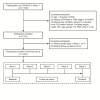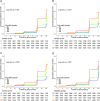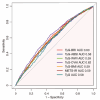Association of novel triglyceride-glucose-related indices with incident stroke in early-stage cardiovascular-kidney-metabolic syndrome
- PMID: 40707904
- PMCID: PMC12291248
- DOI: 10.1186/s12933-025-02854-x
Association of novel triglyceride-glucose-related indices with incident stroke in early-stage cardiovascular-kidney-metabolic syndrome
Abstract
Background: Emerging triglyceride-glucose (TyG)-related indices, such as the TyG-related body roundness index (TyG-BRI), a body shape index (TyG-ABSI), weight-adjusted waist index (TyG-WWI), and Chinese visceral adiposity index (TyG-CVAI), have gained attention as promising predictors of diverse cardiometabolic conditions. Nevertheless, their prospective associations with stroke onset remain insufficiently characterized, especially in individuals affected by cardiovascular-kidney-metabolic (CKM) syndrome.
Methods: This prospective cohort study included 7,503 middle-aged and older adults with CKM syndrome stages 0-3 (see Methods: Definition of CKM Stages 0 to 4) from the China Health and Retirement Longitudinal Study (CHARLS). Cox proportional hazards models were used to evaluate the associations between TyG-related indices and incident stroke, with potential non-linear relationships examined via restricted cubic splines (RCS). Discriminative performance was compared using receiver operating characteristic (ROC) curves. Mediation analysis was conducted to assess whether systolic blood pressure (SBP) mediated the associations. Subgroup and sensitivity analyses were also performed to verify robustness.
Results: Over a median follow-up of 5.2 years, 625 participants (8.33%) experienced a first stroke (incidence rate 102.18 per 10,000 person-years). In fully adjusted models, each 1-SD increase in TyG-BRI, TyG-ABSI, TyG-WWI, and TyG-CVAI was associated with stroke hazards of 1.16 (95% CI, 1.06-1.27), 1.10 (1.01-1.21), 1.13 (1.03-1.25), and 1.20 (1.10-1.31), respectively. Participants in the highest TyG-CVAI quartile had a 67% higher risk than those in the lowest (HR, 1.67; 95% CI, 1.28-2.18). Nonlinear thresholds were identified at TyG-BRI 18.16 and TyG-WWI 78.93. ROC analysis indicated that TyG-CVAI had the greatest discriminative ability for predicting stroke. SBP mediated 26.3-32.9% of these associations. The findings were consistent across multiple subgroup and sensitivity analyses.
Conclusion: Novel TyG-related indices, particularly TyG-CVAI, showed significant and incremental predictive value for stroke risk among individuals with CKM syndrome stages 0-3. Their incorporation into risk stratification frameworks may enhance early detection and prevention of cerebrovascular events in metabolically vulnerable populations.
Keywords: CKM syndrome; Stroke risk, systolic blood pressure; TyG-related indices; Visceral adiposity..
© 2025. The Author(s).
Conflict of interest statement
Declarations. Consent for publication: Not applicable. Competing interests: Dr. Hashimoto reports receiving research funding from Otsuka (Japan) and speaker honoraria from Abbott (Costa Rica) outside the submitted work. All other authors declare no conflicts of interest. Ethics statement: The study involving human participants was reviewed and approved by the Ethics Committee of Peking University. All participants provided written informed consent prior to their inclusion in the study.
Figures






Similar articles
-
Triglyceride-glucose-related indices and risk of cardiovascular disease and mortality in individuals with cardiovascular-kidney-metabolic (CKM) syndrome stages 0-3: a prospective cohort study of 282,920 participants in the UK Biobank.Cardiovasc Diabetol. 2025 Jul 10;24(1):277. doi: 10.1186/s12933-025-02842-1. Cardiovasc Diabetol. 2025. PMID: 40640813 Free PMC article.
-
Association between modified triglyceride glucose indices and stroke risk in middle-aged and older Chinese adults: a prospective cohort study.Cardiovasc Diabetol. 2025 Jul 10;24(1):274. doi: 10.1186/s12933-025-02827-0. Cardiovasc Diabetol. 2025. PMID: 40640840 Free PMC article.
-
Triglyceride glucose-weight-adjusted waist index as a cardiovascular mortality predictor: incremental value beyond the establishment of TyG-related indices.Cardiovasc Diabetol. 2025 Jul 30;24(1):306. doi: 10.1186/s12933-025-02873-8. Cardiovasc Diabetol. 2025. PMID: 40739633 Free PMC article.
-
Triglyceride-glucose-body mass index and the incidence of cardiovascular diseases: a meta-analysis of cohort studies.Cardiovasc Diabetol. 2025 Jan 22;24(1):34. doi: 10.1186/s12933-025-02584-0. Cardiovasc Diabetol. 2025. PMID: 39844258 Free PMC article. Review.
-
Does diabetes modify the triglyceride-glucose index associated with cardiovascular events and mortality? A meta-analysis of 50 cohorts involving 7,239,790 participants.Cardiovasc Diabetol. 2025 Jan 27;24(1):42. doi: 10.1186/s12933-025-02585-z. Cardiovasc Diabetol. 2025. PMID: 39871273 Free PMC article.
References
-
- Ndumele CE, Rangaswami J, Chow SL, Neeland IJ, Tuttle KR, Khan SS, et al. Cardiovascular-Kidney-Metabolic health: a presidential advisory from the American heart association. Circulation. 2023;148(20):1606–35. - PubMed
MeSH terms
Substances
LinkOut - more resources
Full Text Sources
Medical
Miscellaneous

